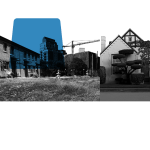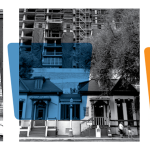In October 2016, Changelab Solutions brought together a remarkable group of community development organizations to discuss how to better connect housing and health. As I sat in the audience and listened to the Bon Secours representatives describe their work in Baltimore, I had 2 thoughts.
First, I was deeply inspired by the thoughtfulness they bring to their community development work. They embrace both “community” and “development.” While the community development field has incredible capacity to leverage private financing for reinvestment, the voice of those in the community is often lost in the quest to demonstrate financial returns and social impact.
Community building is a fraught, time-intensive, and messy process, and it is not easily reduced to quantifiable outcomes. What impressed me about Bon Secours is that they leverage their strengths as a powerful institution with access to capital and real estate expertise. But the staff also manage to stay humble about not knowing all the answers, and are proponents of letting residents drive interventions.
Bon Secours has shown the positive results that can be generated when a hospital steps out of its traditional role and takes on the social determinants of health.
Second, I felt optimistic that an incoming Democratic administration would support and strengthen the federal policies needed not only to support the work of groups like Bon Secours, but also to tackle the larger structural inequities that keep West Baltimore’s neighborhoods poor.
My, how times have changed. While I have no doubt that Bon Secours will continue to fight for its residents and neighborhoods, my optimism about a federal policy framework that supports, rather than hinders, the work of the community development field has certainly faded. Under the Trump presidency, community development is going to find itself, yet again, “swimming against the tide” of federal policies that undermine progress toward social, economic, and racial justice.[1]
While it is too early to say definitively what policies are going to be pursued under the current administration, Trump’s original promises to dismantle the Affordable Care Act (ACA), rollback consumer financial protections, and extend corporate tax cuts will only ensure that capital continues to flow to the wealthiest households. A study by the Tax Policy Center found that the Republican plan to replace the ACA would significantly cut taxes for the highest-income households — an average benefit of $33,000 for the top 1% of households and $197,000 for those in the top 0.1% — while modestly raising taxes for those in the bottom 60%.[2]
No amount of local investment can counteract this scale of federal income redistribution. In addition, Trump’s rhetoric of a violent and broken inner city relies on racism, fear, and deficit-focused language that turn attention toward individual pathologies and away from the structural forces that have produced racially segregated areas of concentrated poverty in cities like Baltimore.
The voice of those in the community is often lost in the quest to demonstrate financial returns and social impact.
While the Trump administration presents an unprecedented challenge to the community development field, in some ways community development has long failed to engage in movements that address the larger structural forces that shape neighborhood inequities. Over the past 40 years, the community development field has shifted from grassroots organizing to leveraging private capital for local development, a shift that has led to both positive and negative outcomes.
This shift has created a dichotomy in the community development field. This is most evident in place-based policies like HOPE VI, which sought to deconcentrate poverty through mixed-income redevelopment and neighborhood revitalization.
Many of these redeveloped sites have been vastly improved, creating healthier communities and providing families with safer, high-quality homes. But in seeking to “deconcentrate” poverty, rather than tackling the labor market policies that keep many families poor, HOPE VI has failed to live up to its promise, contributing to displacement and doing little to promote integration or economic mobility.[3]
A recent study by Raj Chetty also provides compelling evidence that place matters. He shows that moving low-income children to neighborhoods with better schools and lower poverty rates can improve their future economic well-being.[4] Yet Chetty’s headline finding — that young children who moved to better neighborhoods earned, on average, $3,500 more annually than the control group — obscures the fact that their mean earnings were just $14,500, still well below the poverty line and certainly far from a living or middle-class wage.
So, let’s use the next 4 years to think bigger, and more progressively, about the future of community development. Certainly, the community development field should continue to focus on its strengths: building and preserving affordable housing, promoting economic and workforce development, creating healthier environments, and expanding access to financial and other social services. But it’s also time for the field to stop “swimming against the tide” and use the power of community engagement to shift the tide toward more equitable federal policies.
How can an institution like Bon Secours contribute to this shift? Lessons from past social movements suggest that to build the power and scale necessary to effect transformative change, there must be more than a few powerful voices.
Those most affected need to participate in civic life. Bon Secours’ long-standing engagement with West Baltimore has empowered residents to address the challenges in their neighborhood, building a strong foundation for broader political mobilization.
Let’s use the next 4 years to think bigger, and more progressively, about the future of community development.
I would argue that the next step is to empower those same residents to connect to coalitions and social movements like #BlackLivesMatter or the “Fight for $15,” which are organizing for change at the state and federal levels. Bon Secours should again let residents take the lead in this work and be prepared to step into new supportive roles: paying residents to do community organizing, producing materials that educate people about how federal policies affect their day-to-day lives, or hiring lawyers who can challenge abuses of power.
Bon Secours can also help to generate a shift away from language that emphasizes difference and deficit. They can help us embrace messages that focus on commonalities and frames that reflect, and respect, how most people think of themselves — as citizens, workers, parents, and neighbors.[5]
Setting aside staff time to do policy advocacy that humanizes residents and that highlights community assets can promote new ways of thinking about and addressing concentrated poverty. Indeed, these roles and tasks fall outside the typical boundaries of the health care system. But Bon Secours has shown the positive results that can be generated when a hospital steps out of its traditional role and takes on the social determinants of health.
[1] Alice O’Connor (1999). “Swimming against the Tide: A Brief History of Federal Policy in Poor Communities,” in Ronald F. Ferguson & William T. Dickens (eds.) Urban Problems in Community Development, pp. 77–137.
[2] Gleckman, Howard. “Repealing the Affordable Care Act Would Cut Taxes for High Income Households, Raise Taxes For Many Others.” Tax Policy Center, December 15, 2016. http://www.taxpolicycenter.org/taxvox/repealing-affordable-care-act-would-cut-taxes-high-income-households-raise-taxes-many-others.
[3] Chaskin, Robert J., and Mark L. Joseph. Integrating the Inner City: The Promise and Perils of Mixed-Income Public Housing Transformation. University of Chicago Press, 2015.
[4] Chetty, Raj, Nathaniel Hendren, and Lawrence Katz. 2016. “The Effects of Exposure to Better Neighborhoods on Children: New Evidence from the Moving to Opportunity Project.” American Economic Review 106 (4). http://scholar.harvard.edu/hendren/publications/effects-exposure-better-neighborhoods-children-new-evidence-moving-opportunity
[5] Alice O’Connor (2001). Poverty Knowledge (Princeton, NJ: Princeton University Press), p. 293.
Carolina Reid is a member of the BLOCK Project’s Community of Practice and an Assistant Professor in the Department of City and Regional Planning at the University of California, Berkeley.


